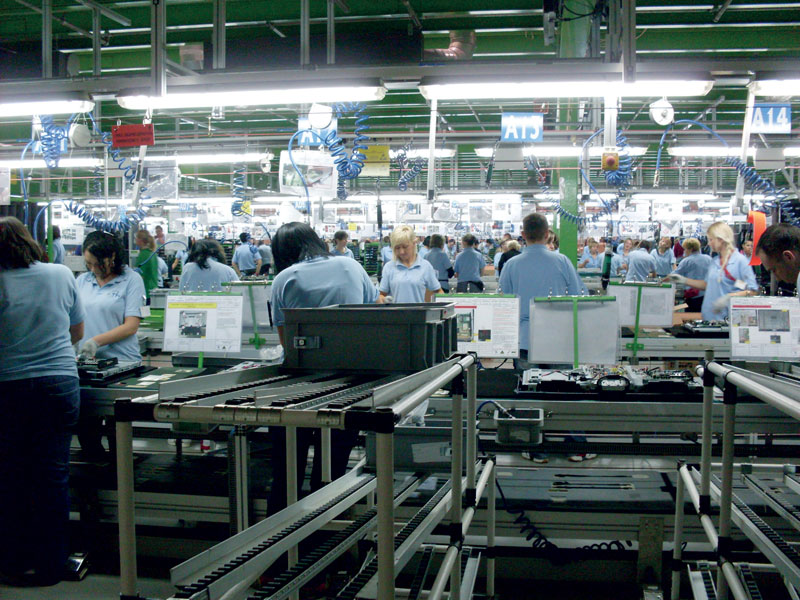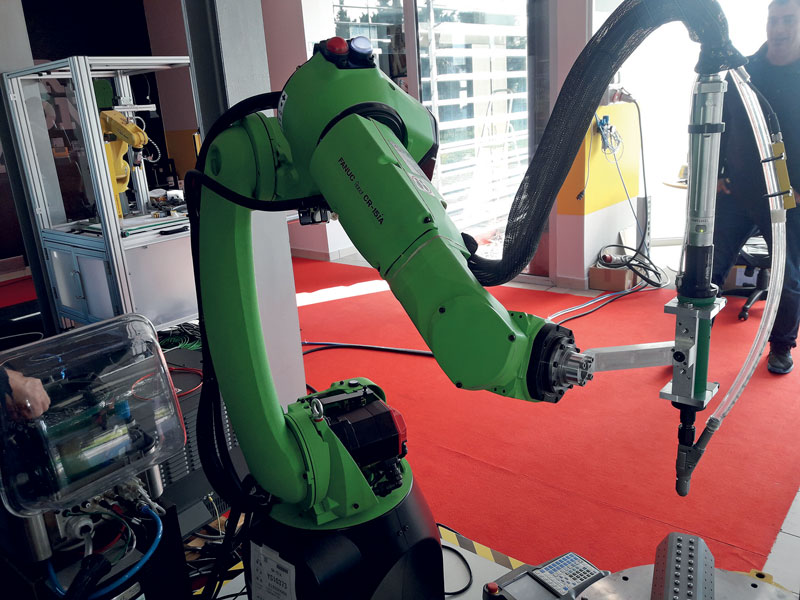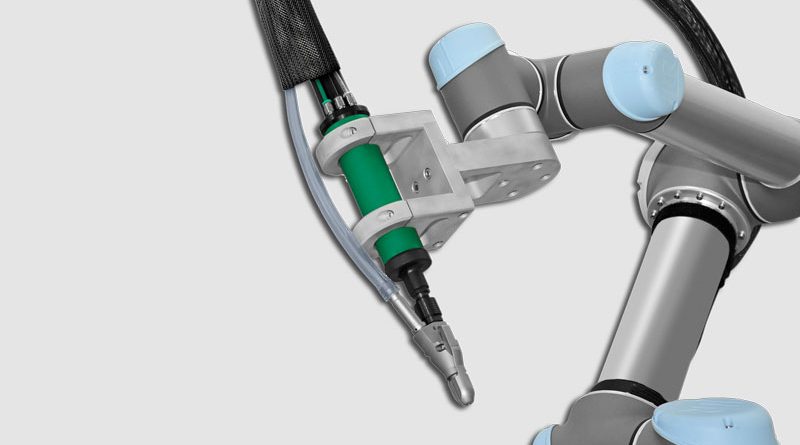When automation includes screw tightening
Factories and plants are changing, increasingly heading towards an interconnected and automated industry; the screw tightening sector, of course, was not just a spectator: semi-automatic and automatic systems, ideal for use with collaborative robots, are becoming established on the market. Nicola Bacchetta, Sales & Marketing Director of FIAM, talked to us about this topic during one of his speeches at Assembly Week.
Today’s productivity requirements result in an increasing use of semi-automated systems, which are becoming an important aid for humans. When is their presence essential and how can they improve the work of operators?
Actually, nowadays the productivity requirements of companies increasingly determine the use of semiautomatic or automatic production systems, therefore also the screw tightening phases follow this trend. The main requirements leading to the use of these systems are: saving time, avoiding screw manipulation, improving the ergonomics of the work phase, and increasing standard components and phases. It must also be said that in contexts where production cycles involve high screw/hour rates, ergonomic aspects are essential for operators who must be protected from highly repetitive movements during work shifts. Automation therefore becomes an aid for operators and the association “more automation, less workers” should be rejected, especially if we look at semi-automatic tools which reduce operator fatigue while increasing productivity by up to 35%.
When we talk about semi-automatic systems, we mean tools which require the help of the operator and which are essential when it comes to tightening medium and large batches of equal screws. Besides, they foresee the continuous supply of screws which are automatically sent to the tightening point, and eliminate the manual phases of screw picking and their positioning on the blade or on the piece. These systems have evolved over time and involve the use of multiple technologies: in addition to pneumatics, they also include electrical or electronic technologies which are increasingly in demand in Industry 4.0 environments.

Besides semi-automatic systems, there are also fully automatic systems, rather different from the “cousins” we just mentioned. Could you explain what differentiates them and what added value they bring to assembly systems?
Unlike semi-automatic screwdrivers, their “cousins”, that is, the automatic solutions, are autonomous screw tightening modules (except for applications on cobots) composed of a screw tightening motor installed on a slide and driven remotely. These are real plug & play systems ready and tested to be immediately integrated on existing production systems and increase the production capacity, for instance assembly lines, rotary tables, manipulators, electric Cartesian axes, robots or cobots. Even here the tightening cycle is always managed and controlled by the PLC integrated in the solution, which in the case of automation is particularly important as it relates to the automated production systems present in 4.0 factories. They can also employ different technologies such as pneumatic, electrical or electronic; the latter, for the purposes of flexibility and production versatility, allows the system to be programmed to perform different assemblies with different parameters of torque, speed, etc., and therefore be used and converted for more components and/or applications.
All the components for industrial automation are entirely designed and produced within FIAM to be installed on the machine, and therefore present specific properties for automation with multiple technologies suitable for any level of accuracy and precision, and all in any case ideal for integration into any smart production. By components we mean, for instance, slides, screw feeders equipped with PLC, screw feeding heads; all elements which are always customized on the screw and on the component to be tightened and the cycle that the process demands. When designing and manufacturing these components, the critical aspects which automatic use entails must always be taken into consideration, and this is why it is important to rely on specialists in the field. As an example, screw retention in automatic handling: it is a critical element in the use of systems for screwing on robots because the type of system used to “ retain” the screw after it has been automatically shot into the tightening head is decisive. During movements, the screw can fall because it is not firmly held, or because the arm hits obstacles and this situation, that is, the loss of the screw inside the components, must be absolutely avoided. We have a “mechanical” system which retains the screw and it is largely preferable to the suction system because it is more effective in ensuring a secure grip of the screw and avoiding problems of screw loss. It must be pointed out that the suction systems, widely used on the market, are not indicated, for example, in the presence of components to be screwed in plastic material: after several screwing operations performed, the components can release dust which is sucked by the system, enters the screwing head and settles on the walls. This situation of “dirt inside the devices” can compromise both the perfect tightness of the screw due to lack of adherence and its correct positioning due to dust deposits. All this translates into production stoppages and increased frequency of maintenance interventions.
When talking about automatic screw tightening systems, it is impossible not to mention collaborative robots. What solutions does FIAM propose for cobots? Could you describe them?
The trends tell us that these “intelligent machines” or collaborative robots will be increasingly present in companies. But, beware, they are not solutions destined to replace humans but rather to cooperate with them in order to relieve them of the most burdensome and dangerous tasks and allow them to represent the real added value in work activities. The operators, that is, humans, become the ideal actors to carry out complex operations and their skills are extended through a mechanism of “job enlargement” in which they are asked to carry out more critical activities in order to make daily work more motivating and with more qualified tasks. The automation process can begin with what are called “screw presenters”, that is, screw feeders with which the cobot carries out the screw pick & place phase and then proceeds with tightening. But the real advantage in terms of time is obtained by using systems with automatic feeding and screw firing: the selection and subsequent firing of the screw take place in “masked” time during the tightening phase with a real and important saving in terms of time.
Fiam screw tightening devices, with any technology, pneumatic, electric or electronic, can be perfectly matched to all collaborative robots on the market and are used more and more frequently as they are ideal for: automating repetitive operations and making the best use of operators’ skills; automatically performing the best part of the tightening phases; being quickly reprogrammed and converted for different applications. They are also easy to program, characterized by very fast set-up times, can be integrated into Industry 4.0 environments and above all are very safe.
Thanks to these characteristics of flexibility, collaboration and simplification, collaborative machines will become increasingly popular and in uses not only confined to companies. Several studies have shown that the introduction of robots leads to increased employment, the “virtuous cycle of robotics”: automation reduces production costs and consequently the price of products, this leads to an increase in demand, and in turn an increase in the workforce.

The appropriate design of components is a very important issue for assembly, because the quality of the final product depends on it. Could you elaborate on this aspect?
This is an important issue which introduces the automation of screw tightening processes. Over the last few years we have raised great awareness in our customers’ design and engineering departments with widespread training activities, handbooks and any useful tool to increase the awareness of product designers on this highly critical aspect. Inadequately designed products with screws positioned in screwing points which are almost impossible to reach, have a strong impact downstream in the production lines and it is unfortunately not uncommon for us to find and have to solve problems of this type with systems which are often very expensive because they are custom designed.
Regarding the automation of processes and therefore also of the screw tightening phases, many aspects must be considered as early as the product engineering phase in order to prepare “upstream” the work on the production process. For example: reducing possible product variants (that is, versions with additional functions, customization, etc.) and therefore using, as far as possible, common components on the product range; paying attention to the type of materials, and making choices not only according to their cost but also adequate to their quality; verifying the geometry of the overall dimensions, that is, where to position the threaded elements in order to optimize the number and types of screws required even depending on the product variants. Finally, it is also important to consider the production layout and make it suitable for the use of automation, verifying the spaces for the positioning of components and their correct manual or automatic handling. All things considered, it is necessary to standardize the components and their constituent elements and to consider the production process as a whole.
These results can be obtained by strongly focusing on the synergy between the design area and the industrialization area of the company; in fact, this goal is not always clear in the mind of those who work on their products: a bridge is necessary, that is, a technical mediation leading to truly lean production processes. With this in mind, more and more companies are involving us right from the design stage, and this represents a truly important and distinctive element of value for our customers.
Finally, I would like to conclude with a key theme for today’s factory: digitization. Could you provide us with some examples of interaction with the factory system? And, besides, how important is data storage in screw tightening systems?
Automatic and semi-automatic tightening systems also represent an answer to the needs of digitization because they are intelligent tools and therefore “smart” already equipped with features useful for digitization. This is considered as a tool to use data to create value through the optimization of production processes; for us, data are those exchanged with and from the screw tightening system. When automatic screw tightening systems are used with electronic motorization, this ensures not only extremely high precision but also complete interaction with the factory system. In practical terms, we have the possibility of storing screw tightening data for statistics and translating them into process productivity/quality analysis data, into analysis and monitoring KPIs.
One example is a recent Polish case: one of Europe’s largest manufacturers of television sets with a plant employing more than 500 operators, currently equipped with five collaborative robots in the production lines and the goal is to reach 20 total units in 2021. Robotizing some operating stations which perform screw tightening operations automatically also meets the need to implement the working distances imposed by the recent health emergency. The introduction of collaborative robots for repetitive operations and to accompany and support operators also opens up very wide service scenarios: for instance, the interconnection with the warehouse for the automatic picking of components or operations and actions complementary to screw tightening. Among other things, “robotization” makes it possible to adapt automatic screw tightening systems to increasingly varied and changing production flows consisting of an ever-increasing number of product variants to be processed, with different materials and types of screws to be used, on multiple and often diversified production shifts. In practice, it enables the management of the complexity of production batches, situations which involve the programming of production cycles. Besides, the in-process controls offered by the screw tightening devices help to verify the quality of the production in real time, and prevent several errors from accumulating right up to the end of the process; post-process controls, on the other hand, allow to collect data, monitor processes and carry out quality checks. The interaction with the factory system brings important advantages, including: remote management of the screw tightening system to carry out monitoring, controls, diagnostics, maintenance or programming of the production cycles; interconnection with the line PLC and other devices, for instance, the possibility of interfacing with the conveyor belt by activating or deactivating any piece-locking jigs and therefore depending on the different components to be assembled and the relative screw tightening programs set; managing the number of screw tightening cycles for the different types of components as well as the relative different torque/angle/time parameters and therefore manage several components to be tightened with unique solutions; count the screws/working cycles, activate maintenance operations, recharge the screw feeder to guarantee production continuity; check the correct sequence of the pre-set screw tightening operations; detect any process anomalies, for example, lack of thread on screws; interface with the machines remotely via field bus.

